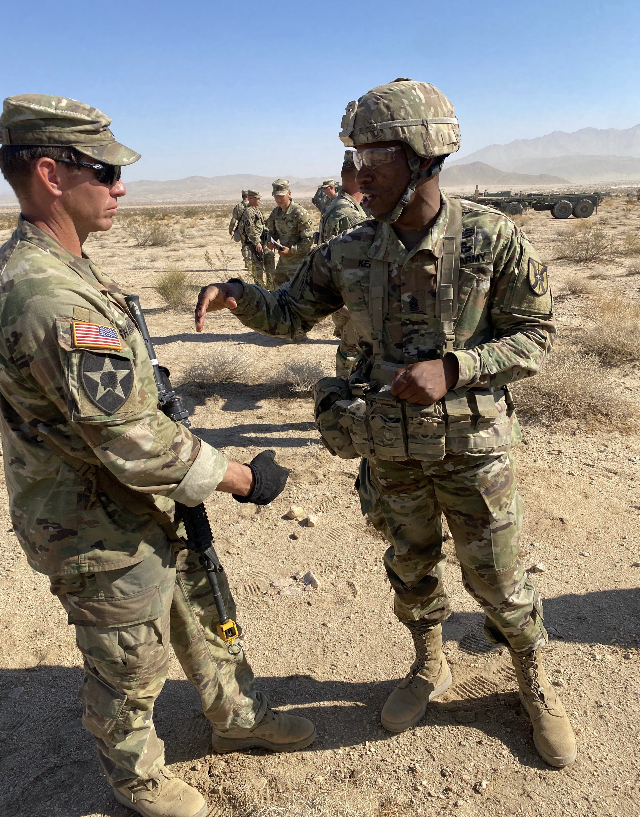
CSM Montrell L. Kea (right) talks about CLIX distribution with an NCO
from a rotational training unit at the National Training Center.
MSG Half-Mast recently spent some time out at the National Training Center (NTC), in the “sandbox,” with Command Sergeant Major (CSM) Montrell L. Kea, the 916th Support Brigade's (BDE's) senior enlisted Soldier. CSM Kea assumed his current duties in June of 2021.
A native of Currie, North Carolina, CSM Montrell L. Kea joined the Army in 1997. He’s held a variety of command and staff positions during his career, including platoon sergeant, battalion (BN) S4 supply NCOIC, first sergeant and operations sergeant. Just prior to his current duties, he served as the 1st Armored Division G4 Supply and Services CSM and 123rd Brigade Support BN CSM, both at Fort Bliss, TX. He holds a Bachelor of Science degree in Business Management from University of Phoenix and a Master’s of Science degree in Human Resources from Excelsior College.
MSG Half-Mast: CSM Kea, Sustainer Seven, Hoo-ah! We appreciate you taking the time to speak with PS Magazine. I know you’re a graduate of both the Airborne and Jumpmaster courses, but I’m not getting any younger, so I don’t plan on jumping out of any airplanes with you today. Could you briefly describe the mission of the 916th Support BDE?
CSM Kea: The 916th is the only BDE of its type in the Army. Our mission is to oversee and operate sustainment nodes across the entire operational environment (OE) to maximize rotational unit readiness within the sandbox.
We employ four (4) locomotives that enable units to get their equipment from home station to the NTC and back to home station. During rotations, we actually serve as an echelon above BDE for mission command of sustainment and aviation assets.
Finally, supporting units post-rotation is very important. We help them regenerate their equipment with deliberate efforts to increase their overall readiness.
MSG Half-Mast: What makes maintenance and logistics especially challenging for units rotating through the NTC? Do weather and the environment—e.g. extreme temperatures, long distances and rough terrain—pose any special readiness concerns for units and how can they better prepare for them?
CSM Kea: Many factors play a role in challenging rotating units’ maintenance and sustainment success at the NTC. Among them: competing requirements, stress, fatigue, weather and being unfamiliar with the operating environment. Also, units often try to apply maintenance practices they conduct at home station to the NTC. The conditions are often radically different. We recommend units modify their sustainment practices based upon how they intend to sustain their force in the current fight and OE. This will help them be successful at the NTC, as well as other training exercises and deployments.
Prior to arrival at the NTC, operators and maintainers should definitely account for weather. Equipment with A/C should be serviced and inspected in the summer months. In the winter months, rotational units need to make sure that heaters are serviced and working properly.
MSG Half-Mast: What are some of the major maintenance and supply lessons—both positive and negative—that units, including your own, learn when training/operating at the NTC?
CSM Kea: We’ve noticed that rotational units are often reluctant to place deadlined equipment on the Equipment Status Report (ESR). We always coach units that, if it’s broke, put it on the ESR. That means you have Class IX (CLIX) leveraged against it, the BDE Combat Team (BCT) is tracking it and it provides leadership an illustrated understanding of their actual combat power. The best practice for units is checking ZPARK within GCSS-Army frequently for their not-mission-capable supply (NMCS) parts that are required for their down equipment.
Also, a major key to success is reaching out early to enabler units and division sustainment support battalion (DSSB) units on the challenges with getting parts funded and released during the NTC rotation.
Additionally, successful units begin developing a regeneration plan prior to the NTC rotation and employ maintenance surge teams to complement the BCT’s regeneration effort. This is even more effective when a support area command post (SACP) is working in tandem with the surge teams.
MSG Half-Mast: Please identify three things units preparing for their next rotation must do to increase the chances they’ll successfully execute the sustainment warfighting function.
CSM Kea: On the maintenance side, they need to ensure that they have their Class IIIP ordered at least 60 days out. And units need to bring all of their special tools, like pack slings and ground hop kits.
We highly recommend that 91Cs get trained up to use gauges for A/C services rather than using A/C reclaimers. Having Soldiers that can use gauges and maintain A/C systems for tactical equipment is vital to success at NTC.
Units need to remember that they’ll be stressed for time because they’ll be moving locations every 48 to 72 hours. They must be prepared to push CLIX often. The most successful units establish a battle drill or incorporate methods to conduct CLIX pushes as often as they physically can.
To be successful at the NTC, prior to deploying, it’s critical that units conduct a deliberate inventory of all basic issue items (BII) required to operate equipment. Not bringing everything required to operate equipment is a common mistake that we see at the NTC. It frustrates units because they find they’re missing some special tool or adaptor and cannot configure their equipment to operate as intended.
MSG Half-Mast: Any final thoughts you’d like to send to PS readers?
CSM Kea: The sustainment warfighting function requires critical thinking, forecasting, understanding and experience to be employed effectively. Through it all, leadership in the sustainment community must be agile enough to offer up feasible sustainment plans but also willing to adjust quickly when those plans prove infeasible. Feasible sustainment plans ensure that conditions are set to execute the delivery of supplies and equipment.